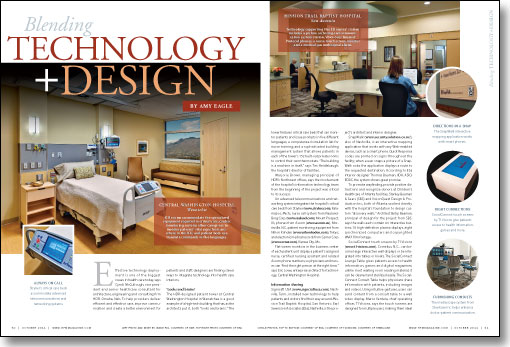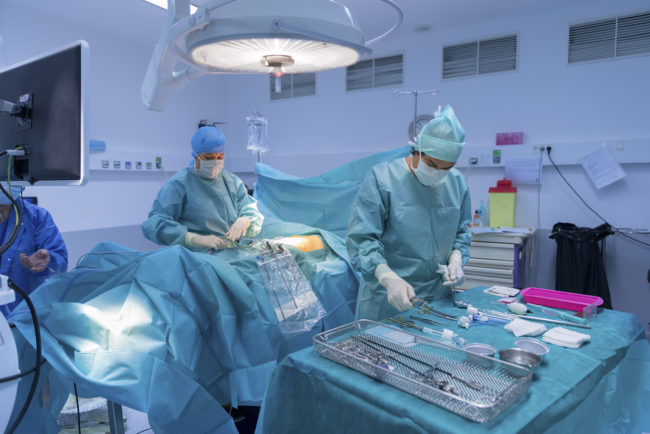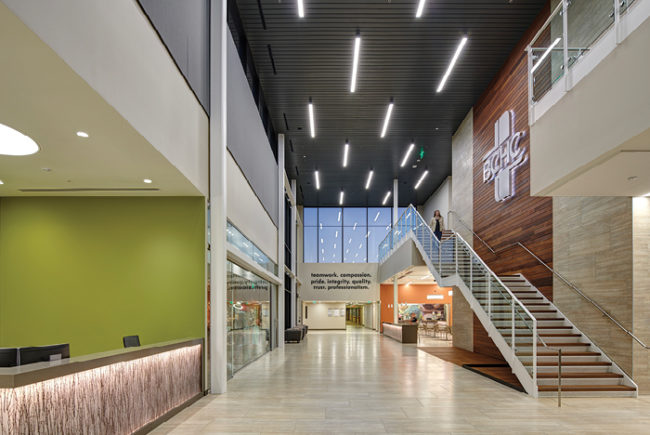Blending technology + design (PDF)
Effective technology deployment is one of the biggest issues in health care today, says Cyndi McCullough, vice president and senior healthcare consultant for architecture, engineering and consulting firm HDR, Omaha, Neb. To help providers deliver efficient and effective care, improve communication and create a better environment for patients and staff, designers are finding clever ways to integrate technology into health care interiors.
'Looks and brains'
The HDR-designed patient tower at Central Washington Hospital in Wenatchee is a good example of a high-tech building that has, as the architects put it, both "looks and brains." The tower features critical care beds that can monitor patients and issue prompts in five different languages; a computerized simulation lab for nurse training; and a sophisticated building management system that allows patients in each of the tower's 152 built-out private rooms to control their own thermostats. "The building is a machine in itself," says Tim Heidlebaugh, the hospital's director of facilities.
Marjorie Brown, managing principal of HDR's Northwest offices, says the involvement of the hospital's information technology team from the beginning of the project was critical to its success.
An advanced telecommunications and networking system integrates the hospital's critical care beds from Stryker (www.stryker.com), Kalamazoo, Mich.; nurse call system from Rauland-Borg Corp. (www.rauland.com), Mount Prospect, Ill.; phones from Ascom (www.ascom.us), Morrisville, N.C.; patient monitoring equipment from Nihon Kohden (www.nihonkoden.com), Tokyo; and electronic medical records from Cerner Corp. (www.cerner.com), Kansas City, Mo.
Flat-screen monitors in the business center of each patient unit display a patient's assigned nurse, certified nursing assistant and related Ascom phone numbers, so physicians and nurses can "find the right person at the right time," says Eric Lowe, enterprise architect for technology, Central Washington Hospital.
Information sharing
Signcraft USA (www.signcraftusa.com), Nashville, Tenn., installed new technology to help patients and visitors find their way around Mission Trail Baptist Hospital, San Antonio. Earl Swensson Associates (ESa), Nashville, is the project's architect and interior designer.
SnapWalk (www.securitysolution.co.in/), also of Nashville, is an interactive mapping application that works with any Web-enabled device, such as a smart phone. Quick Response codes are printed on signs throughout the facility; when a user snaps a picture of a SnapWalk code, the application displays a route to the requested destination. According to ESa interior designer Thomas Bauman, IIDA, ASID, EDAC, the system shows great promise.
To promote wayfinding, provide positive distractions and recognize donors at Children's Healthcare of Atlanta facilities, Stanley Beaman & Sears (SBS) and VisionQuest Design & Production Inc., both of Atlanta, worked directly with the hospital's foundation to design custom "discovery walls." Architect Betsy Beaman, principal of design for the project from SBS, says the walls each contain six interactive buttons, 18 high-definition plasma displays, eight synchronized computers and copyrighted IMAX film footage.
SocialConnect touch screens by T1Visions (www.t1visions.com), Cornelius, N.C. , can become large interactive wall displays or be integrated into tables or kiosks. The SocialConnect Lounge Table gives patients access to health information, games and digital magazines; unlike most waiting room reading material, it can be cleaned and sterilized easily. The SocialConnect Consult Table helps physicians share information with patients, including images and videos. Using intuitive gestures, users can send content from a consult table to a wall video display. Marco Ventura, chief operating officer, T1Visions, says the touch screens are designed for multiple users, making them ideal for collaborative health care settings. The displays can be customized and branded to suit any organization.
The media:scape system from Steelcase Inc. (www.steelcase.com), Grand Rapids, Mich., integrates furniture and technology to facilitate doctor-patient communication. Using media:scape, caregivers, patients and family members can stand or be seated together at a table or couch and share information from a variety of digital devices on a high-definition video display. A videoconferencing component connects the care team with medical professionals around the world.
Ergonomic tech
The V6 wall station, a new computer wall mount from Humanscale (www.humanscale.com), New York, enables caregivers to position keyboards and monitors for optimal patient interaction and ease of use.
The simple, elegant, space-saving design "quietly does its job and looks good doing it," says Mark Sapp, director of medical products, Humanscale. An internal cable management system makes the V6 easy to wipe down for infection control, and the ergonomic design helps doctors and nurses work comfortably, so they can focus on what they need to, adds Mark McKenna, the company's design director. An ergonomic work environment "may sound like a luxury, but it's basic," says Jane Abernethy, Humanscale's senior medical designer.
The Most Innovative award in the technology support category at the 2011 NeoCon design expo and conference in Chicago went to Steve's Station, an imaging table from Anthro Corp. (www.anthro.com), Tualatin, Ore. The fully adjustable, ergonomic table has features for privacy, lighting, sound absorption and air movement. Michael Mullen, design development manager, Anthro, says installing furnishings with the appropriate lighting, wiring and cable management is "a more thoughtful, easier-to-implement, faster, better experience" for a facility than upgrading a room with costly new wiring and lighting.
Patient experience
Leda Furniture (www.ledafurniture.com), Toronto, takes technology integration into the patient room with its Lounge series Optimum Lift TV, a bureau with a hideaway flat-screen television that can be raised or lowered at the touch of a button. "It keeps the room a little cleaner — not as cluttered," says Marco L. Confalone, president, Leda Furniture. An optional infrared sensor on the front of the unit allows patients and visitors to operate a DVD player or gaming system stored in the cabinet without opening the doors.
Sonata oncology casegoods by Steelcase Inc.'s health care unit, Nurture (www.nurture.com), Grand Rapids, Mich., feature personal flat-screen televisions for each patient and built-in, pop-up outlets to power patients' or visitors' electronic devices.
"Sonata is addressing the patient first, and technology is subtly integrated into it," says Alan Rheault, director of product design, Nurture.
Caroline Kelly, senior design researcher for Steelcase, says the company has developed what it calls the SSI framework for considering technology. Rather than focusing on specific technological devices, which can become obsolete quickly, the SSI framework takes into account the social, spatial and informational aspects of technology use — what users need from the experience, the requirements of the physical environment and how the information is conveyed.
"The use of technology is emerging so fast" in so many new places, says Rheault. "We're still learning and observing and have intentions of continuing to develop products down this road."






